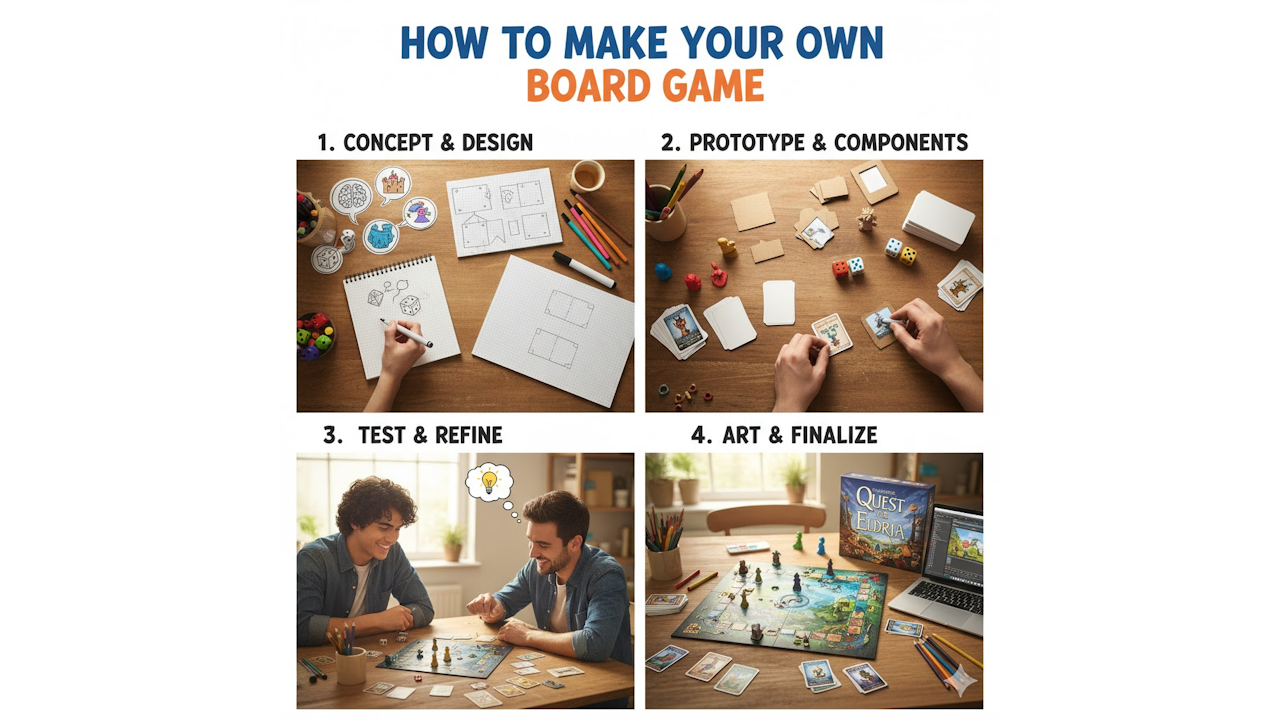Creating your own board game is a rewarding process that combines imagination, design, and problem solving. Whether you want to make a fun family activity or a complex strategy challenge, the steps involved are quite similar. The process includes generating a concept, developing mechanics, prototyping, testing, and refining. With patience and creativity, you can turn an idea into a finished game that entertains and challenges others.
The first step is to come up with a concept. Every game begins with a central idea that gives it identity and purpose. Think about what you want players to experience. Do you want them to compete, cooperate, or explore? Inspiration can come from anywhere: favorite books, history, fantasy worlds, or real-life situations. For example, you might design a game where players build civilizations, solve mysteries, or survive in the wilderness. At this stage, do not worry about the rules or mechanics; focus instead on the theme and feeling you want to create.
Once you have a concept, decide on the target audience. A game for children will look very different from one meant for adults who enjoy strategy. Understanding your audience will help you choose appropriate complexity, style, and tone. You should also consider the number of players and the average playing time. A game designed for two players will require different dynamics than one that supports large groups.
Next, move on to game mechanics, which are the rules and systems that drive gameplay. Mechanics determine how players interact with the board, cards, or tokens. Some common mechanics include dice rolling, card drawing, resource management, tile placement, or area control. The key is to make the rules clear and balanced. Players should have meaningful choices and opportunities to influence the outcome. Think about how turns work, how players progress toward victory, and what actions are available each round. The best mechanics support the theme while providing a mix of strategy and unpredictability.
After you have sketched out the mechanics, begin building a prototype. A prototype does not need to be beautiful; it only needs to function. Use simple materials like paper, index cards, or household objects. Create a basic board layout, mark spaces, and write out cards by hand. Label tokens with stickers or pen marks. The goal is to create something you can test and adjust easily. Do not worry about artwork or color schemes yet, since these come later in the process.
Testing is the heart of board game design. Play your prototype several times on your own first to identify major flaws or confusing sections. Once the game runs smoothly for you, invite friends or family to try it. Watch how they interact with the game and pay attention to what confuses or frustrates them. Ask for feedback about clarity, pacing, and enjoyment. Be open to criticism, because even the best ideas need refining. It often takes many rounds of testing to balance the rules and ensure that every player has a fair chance of winning.
During testing, look for common problems. Are the turns too long or too short? Do players feel engaged throughout the game? Is there a clear sense of progress toward a goal? Does luck overshadow skill, or is there too much complexity for the target audience? Make adjustments after each session. Simplify where possible, since a straightforward rule is usually better than a complicated one. Keep notes on what works and what does not, and do not hesitate to remove or redesign mechanics that do not fit.
Once the gameplay feels balanced, start improving the presentation. Visual design is an important part of player experience. A well-designed board helps players understand the game at a glance and adds to the atmosphere. Use color, symbols, and layout to communicate information clearly. At this stage, you can create cleaner versions of cards and boards using design software or printed templates. Consider the theme and tone when choosing fonts and illustrations. For example, a game about medieval kingdoms might use textured parchment backgrounds, while a futuristic space game could feature sleek metallic designs.
When the visuals are ready, prepare the final prototype. This version should look close to a finished product, even if you are making it by hand. You can print on thicker paper, laminate the board, or use custom tokens and dice. This final prototype is useful for more extensive playtesting or for pitching to publishers if you plan to release the game commercially. Some designers choose to self-publish, while others partner with established companies. There are also crowdfunding options where supporters can help fund production in exchange for early copies.
Throughout the process, document your rules carefully. Write a clear rulebook that explains setup, turn order, special cases, and winning conditions. Organize it logically, with examples and diagrams if possible. The rulebook is often the first thing players read, so clarity is essential. Even a great game can fail if players cannot understand how to play.
Finally, remember that designing a board game is a creative journey. It involves trial, error, and persistence. You will learn as you go, discovering what makes games fun and engaging. Try studying other games for inspiration, but always aim for originality. The best games often introduce a fresh twist on familiar ideas or combine old mechanics in unexpected ways.
In the end, making your own board game is about sharing enjoyment and imagination. Whether your creation becomes a family favorite or a published title, the process teaches valuable skills in storytelling, logic, and design. Start with a simple idea, play often, and keep refining until it feels right. With patience and creativity, anyone can craft a game that brings people together and offers countless hours of fun.

